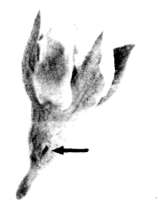MORE
ON THE PEA'S NECTARIES AND INSECT VISITORS
Clement,
S. L, L. A. Lathrop, and F. J. Muehlbauer
USDA,
ARS, Washington State University, Pullman, WA USA
The culinary
pea, Pisum sativum L., is an almost entirely self-pollinated species but the structure of the
plant's flowers indicate that its ancestors were insect-pollinated (7).
Loenning (A) provided further evidence of the pea's adaptation to
cross-pollination by insects in his report on the pea's floral nectaries and
insect visitors (bees and thrips)
.
Another
insect visitor of pea flowers is the pea weevil, Bruchus pisorum (L.) (Coleoptera:Bruchidae),
a worldwide pest of peas. This weevil visits pea flowers to feed on the
pollen, which is required for female weevils (but not exclusively pea
pollen) to develop their eggs (1,6). To our knowledge there are no
reports of the pea weevil collecting nectar from peas.
During
laboratory studies to determine the nature of pea weevil resistance reported (5) in several pea
accessions in the collection maintained at the USDA Plant
Introduction Station, Geneva, New York, we repeatedly observed pea
weevils bite into the base of fresh 1-2 day old 'Alaska' pea flowers.
These flowers were offered to weevils in plastic petri dishes. Weevil
holes were always a small slit (ca. 1.5 mm long) on the concave outer surface of a flower near
the base of the corolla tube (Fig. 1). These holes provided access to
the nectar at the base of the staminal tube and carpel. Other parts of a
flower were never punctured.
Thus, this
behavior fits Inouye's (3) definition of nectar robbing---
"behavior
exhibited by some species of birds, bees, and ants in which nectar is obtained through holes bitten near
the bases of the corolla tubes, in a manner generally circumventing contact
with the sexual parts of the flowers". It also fits his definition of a
primary nectar robber which is "an individual that makes the holes and
then extracts the nectar". Beetles have rarely been implicated
as nectar robbers; indeed, Inouye (3) mentioned only one example of nectar robbing
by a beetle species in his review article.
Presence of
nectar in Alaska peas was confirmed by treating the small amount of liquid at the base of the
flower's staminal tube and carpel with a drop of 5% phenol solution followed by a
drop of concentrated H2SO4. This phenol + H2SO4
solution becomes orange if sugar is present (2). This simple carbohydrate test was used to
detect the presence of nectar in fresh 1-2 day-old flowers of 19 pea lines
from the Pisum germplasm collections at Geneva, New York, and
Landskrona, Sweden. These 19 lines were a sub-sample of a larger number grown in
1.8 x 1.8 m field cages at Pullman, Washington, in 1987. Flowers were
collected in the morning (8-10 AM) and were treated with phenol and
H2SO4 as previously described.
We are in
the process of examining in more detail the nectar robbing behavior of the pea
weevil.
